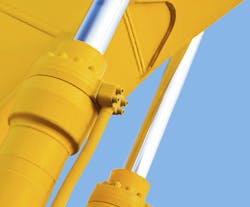I was recently engaged by a client to conduct failure analysis on a large (and expensive) hydraulic cylinder off an excavator. This hydraulic cylinder had been changed-out due to leaking rod seals after achieving only half of its expected service life.
Inspection revealed that apart from the rod seals, which had failed as a result of 'dieseling', the other parts of the hydraulic cylinder were in serviceable condition. The 'diesel effect' occurs in a hydraulic cylinder when air mixes with the hydraulic oil and explodes when pressurized.
When a double-acting hydraulic cylinder retracts under the weight of its load, the volume of fluid being demanded by the rod side of the cylinder can exceed the volume of fluid being supplied by the pump. If this happens, a negative pressure develops in the rod side of the hydraulic cylinder. And this usually results in air being drawn into the cylinder past its rod seals. This occurs because most cylinder rod seals are designed keep high-pressure fluid in and are not designed to keep air out. The result of this is aeration — the mixing of air with the hydraulic oil.
And as already explained, when a mixture of air and oil is compressed it can explode, damaging the hydraulic cylinder and burning its seals. As you have probably gathered, the term 'diesel effect' is a reference to the combustion process in a diesel engine.
Dieseling can result from not purging the cylinder's chambers of air during commissioning. But in the example described above, the cause of the air ingression was a faulty 'float' valve. The function of a float valve on a hydraulic excavator is to allow the boom or arm to be lowered rapidly under its own weight. When activated, this valve connects the ports of the hydraulic cylinder together allowing it to retract under the weight of the boom or arm. The fluid displaced from the piston side of the cylinder is directed with priority to the rod side, before any excess volume is returned to the hydraulic reservoir. An orifice controls the speed with which the hydraulic cylinder retracts. If this valve malfunctions or is set incorrectly, a negative pressure can develop on the rod side of the hydraulic cylinder, causing air to be drawn past the rod seals, leading to failure of the cylinder.
Had the faulty float valve had been identified early enough, the failure of this hydraulic cylinder and the significant expense of its repair could have been prevented. In other words, not checking the operation and adjustment of circuit protection devices at regular intervals can be a costly mistake. And to discover six other costly mistakes you want to be sure to avoid with your hydraulic equipment, get "Six Costly Mistakes Most Hydraulics Users Make... And How You Can Avoid Them!" available for FREE download here.
About the Author
Brendan Casey Blog
Author
Brendan Casey is a war-weary and battle-scarred veteran of the hydraulics industry. He's the author of The Hydraulic Troubleshooting Handbook, Insider Secrets to Hydraulics, Preventing Hydraulic Failures, The Definitive Guide to Hydraulic Troubleshooting, The Hydraulic Breakdown Prevention Blueprint and co-author of Hydraulics Made Easy and Advanced Hydraulic Control. And when he's not writing about hydraulics or teaching it, Brendan is flat-out helping consulting clients from a diverse range of industries solve their hydraulic problems. To contact him visit his company's Website:
www.HydraulicSupermarket.com
Sign up for our eNewsletters
Get the latest news and updates

Leaders relevant to this article:

